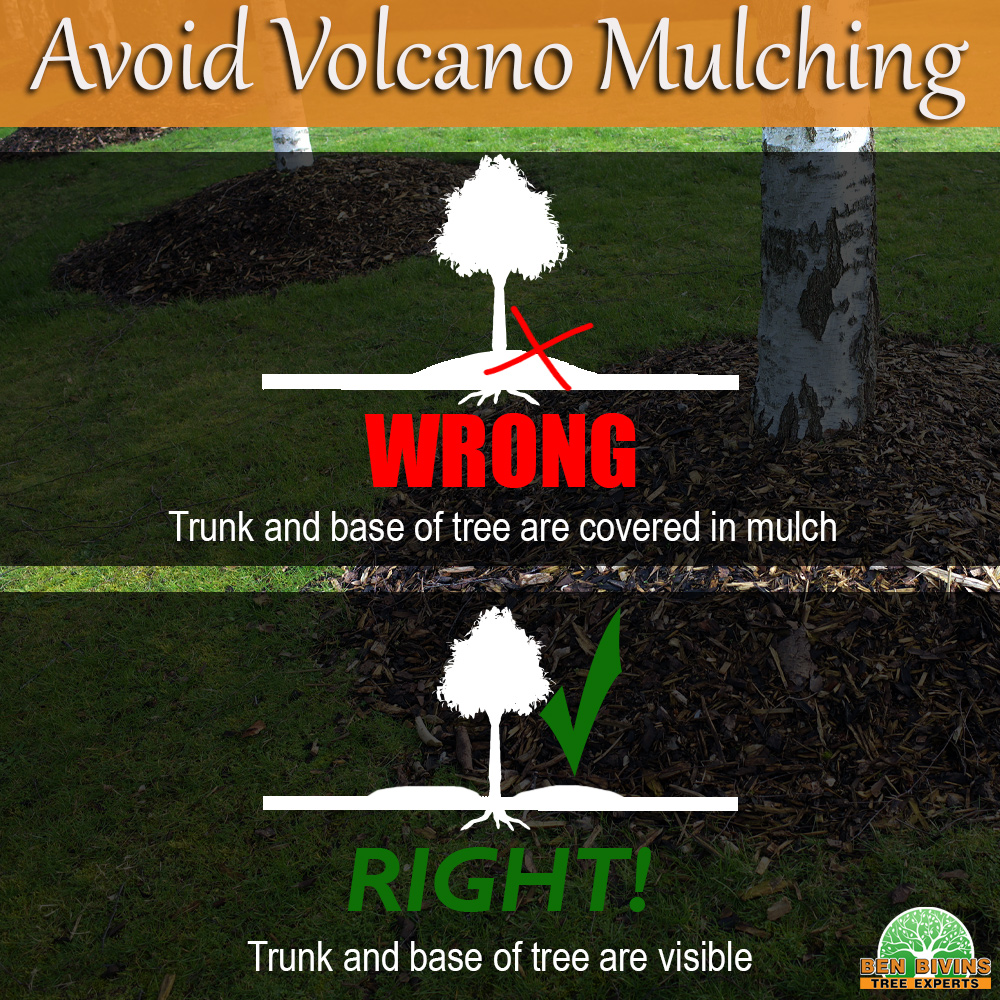When it comes to tree care, there are definitely dos and don’ts. Many people have the set it and forget it frame of mind when it comes to trees. Assuming that trees don’t need regular care and maintenance is a huge misconception. They actually need a small amount of looking after in order to keep them as healthy as possible. The health of trees, especially those on your property, is important because it is directly linked to the safety of the trees. Weak, sickly trees are a danger to your property and to yourself. Falling limbs and tumbling trees can do a lot of damage and cause major injuries. Sometimes knowing what to avoid is as helpful, if not more, when it comes to plant care. If you need help with your trees, one of the best tree companies Ocean County has to offer is Ben Bivins Tree Experts.
Number One Thing Not to Do – Volcano Mulching
Take a walk around your neighborhood and you’ll this this tree sin being committed on a number of properties. Volcano mulching is the practice of building up a mound of mulch all around the base of the tree, leaving no space in between the trunk and the mulch. How it got started or why owners continue to do it is not known. It could be because thick layers of mulch can be very effective at controlling weeds. One may think that piling this much mulch is beneficial for the tree. However, volcano mulching can be very detrimental to the tree’s health for a number of reasons. Mulching can be advantageous to trees if done correctly. The best way to do so is to follow the 3x3x3 rule. Meaning, apply 3 inches of mulch at least 3inches away from the tree trunk in a circle 3 feet wide.
Ways Volcano Mulching is Bad According to Tree Companies in Ocean County
The trunks of trees are not meant to be covered up. Doing so can cause invite a host of problems into your landscape and especially for your tree.
Piling up a large amount of mulch that close to the base and trunk of the tree does terrible things to the roots. It can prevent water from reaching the roots, depriving the tree of nutrients. On the other hand, mulch is also great at retaining moisture. In this way it can also cause roots to rot because the soil may stay too wet.
The moisture that remains due to the mountain of mulch can cause the trunk to rot and be susceptible to diseases. Death and decay are inevitable making the tree very weak and unsafe. The moist conditions are also prime for water-repellent fungi to grow. This oddly enough, forces the tree to exist in drought-like conditions despite there being plenty of water.
Over Pruning is Another Deadly Practice
It can be hard to stop once you start trimming. A branch here, a branch there, and it can quickly get out of hand. Although it may seem like you are doing something good for the tree, over pruning should be avoided. Removing too many twigs, branches, and limbs can seriously harm your tree.
The crown of the tree is very important to a tree. Not only does it provide shade for you, it protects its own trunk as well. When too much of the canopy of a tree is removed, the trunk can suffer from sunscald. Plus, the leaves of the tree are what provides the tree nutrition. The process of photosynthesis is only possible with leaves. Without leaves, sunlight cannot be converted to chemical energy and this starves the tree eventually causing death.
Excessive pruning also provokes uneven and diminished growth. Removing too many limbs on one side of a tree can cause stress on the trunk on the other side. This can cause the tree to topple. Pruning too much, too often can also induce an extreme number of interior sprouts to grow. Both effects make for a visually unappealing and physically weakened tree.
Tree Companies Ocean County Firms Say Neglect Leads to Disaster
While too much work on a tree can be a negative, not doing anything at all is worse. The first step in tree care is selecting the right type of tree for the right location. Planting trees that enjoy shade in the middle of an open field will not end well. The environment will be too stressful for the tree to survive no matter how much care you provide. Once planted, caring for the tree takes work. Visually, you should check your trees for browning leaves, early leaf dropping, imperfections in the bark, and anything out of the ordinary. These could be symptoms of disease or infestations and need to be addressed quickly. Proper pruning techniques can create healthier, more robust trees providing you with optimal benefits.
